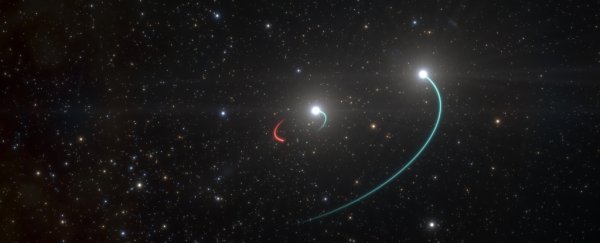We can't see them, but they're out there - stellar-mass black holes, peppering the galaxy. And they're closing in. Astronomers have just identified the closest black hole to Earth they've spotted yet, at less than a third of the distance of the previous record-holder.
This nearby black hole has evaded detection so far since it's very small, and very quiet - detecting black holes is that much harder when they aren't actively slurping down matter from their surrounding space, since they neither emit nor reflect any detectable radiation whatsoever.
But the newly discovered object had a tell. It's in a triple star system, with two B-type main sequence stars, visible from Earth with the naked eye, and previously thought to be a binary system, called HR 6819.
When astronomers took observations of the system as part of a survey on binary stars, they found something awry. The orbits of those two main sequence stars seemed to be tugged askew.
Follow-up observations tracking the star using the MPG/ESO 2.2-metre telescope at European Southern Observatory's (ESO) La Silla Observatory in Chile clinched it. One of the stars, with an estimated mass between 5 and 7 times the mass of the Sun, orbits a gravitational centre of the system every 40 days - not the other star, which is much farther out.
When analysed, these orbits suggested there were not two, but three objects dancing around each other in orbit. Since the third object was invisible, there was one thing it was far more likely to be than anything else.
"An invisible object with a mass at least four times that of the Sun can only be a black hole," said astronomer Thomas Rivinius of the European Southern Observatory. Therefore, "this system contains the nearest black hole to Earth that we know of."
And it's just over 1,000 light-years away. Previously, the closest known black hole, A 0620-00, was measured at a distance of 3,300 light-years away.
There's another paper currently in preparation that will break down the nature of the stars in greater detail, but the team's analysis suggests that the black hole has a minimum mass of around 4.2 solar masses, which would put it in the ballpark of the titchiest black holes.
To date, we have detected no black holes smaller than five solar masses. Whether the HR 6819 black hole will break that record is yet to be confirmed. What the research does show, however, is the viability of searching for black holes by looking for stars that move strangely.
So far, most of the fewer than 50 stellar mass black holes we've detected in the Milky Way have been spotted when they flare with the intense heat and light generated as matter is sucked into them. The technique used in the new research offers a way to find what we estimate to be many, many more black holes that aren't active.
It's not the first time that looking for stars that act weirdly has borne black hole fruit, but each such system we detect gives us more clues.
"There must be hundreds of millions of black holes out there, but we know about only very few," Rivinius said. "Knowing what to look for should put us in a better position to find them."
Systems such as these can also help us to solve outstanding mysteries. For example, observing how three bodies interact in a system that contains a black hole could be important for understanding how multiple-body systems result in the black hole or neutron star collisions that generate gravitational waves.
There's also the case of LB-1, a system that last year was found to have a black hole of "impossible" mass before several other teams of astronomers pinpointed an error in the work. Astronomers are still puzzling over and looking for solutions to explain the system's peculiarities. The answer might be in HR 6819.
"We realised that another system, called LB-1, may also be such a triple, though we'd need more observations to say for sure," said ESO astronomer Marianne Heida.
"LB-1 is a bit further away from Earth but still pretty close in astronomical terms, so that means that probably many more of these systems exist. By finding and studying them we can learn a lot about the formation and evolution of those rare stars that begin their lives with more than about eight times the mass of the Sun and end them in a supernova explosion that leaves behind a black hole."
Triple systems have also been suggested as precursors to black hole or neutron star mergers. In this context, HR 6819 is pretty interesting. In order to collapse into a black hole, the precursor star needs at least a mass of 20 times that of the Sun. A precursor between 8 and 20 times the mass of the Sun produces a neutron star.
The two stars in HR 6819 are thought to hover around 6 solar masses, which will leave white dwarfs. Whether the system is typical or an outlier, however, is yet to be explored.
We can't wait to find out what this amazing system can show us about our Universe.
The research has been published in Astronomy & Astrophysics.
